
This has got to be the most insane fake climate crisis action yet of the many hundreds that we've seen in the last 2 decades.
"Farmers in the Netherlands have been angered by the government's plans for tougher measures that would drastically reduce emissions of nitrogen oxides.
The Dutch government unveiled its goals on Friday, mandating reductions of up to 70% in many places and as high as 95% in others in a bid to protect nature -- or what the cabinet called an "unavoidable transition".
“We have to emit so much less nitrogen, and unfortunately the agricultural sector emits a lot," explained Christianne van der Wal, Minister for Nature and Nitrogen Policy.
Sustainability, relocation or termination are the options that farmers are faced with, and the government has made available €24.3 billion in subsidies during the transitional period.
The nitrogen plan must lead to a 50% reduction in total nitrogen emissions by 2030."
Every crop farmer reading this, completely understands the absolute need for massive nitrogen when growing crops.
This situation is about animals and their nitrogen but without synthetic nitrogen fertilizer, corn yields for instance would be less than half of what they are today.
In fact, the planet would only be able to support around 6 billion people, at the most without man made nitrogen fertilizers.
Another secret about fossil fuels:Haber Bosch process-fertilizers feeding the planet using natural gas-doubling food production/crop yields. September 2019
https://www.marketforum.com/forum/topic/39215/
Look what happened to corn yields below after we started feeding corn high amounts of SYNTHETIC NITROGEN fertilizer:
https://www.agry.purdue.edu/ext/corn/news/timeless/yieldtrends.html
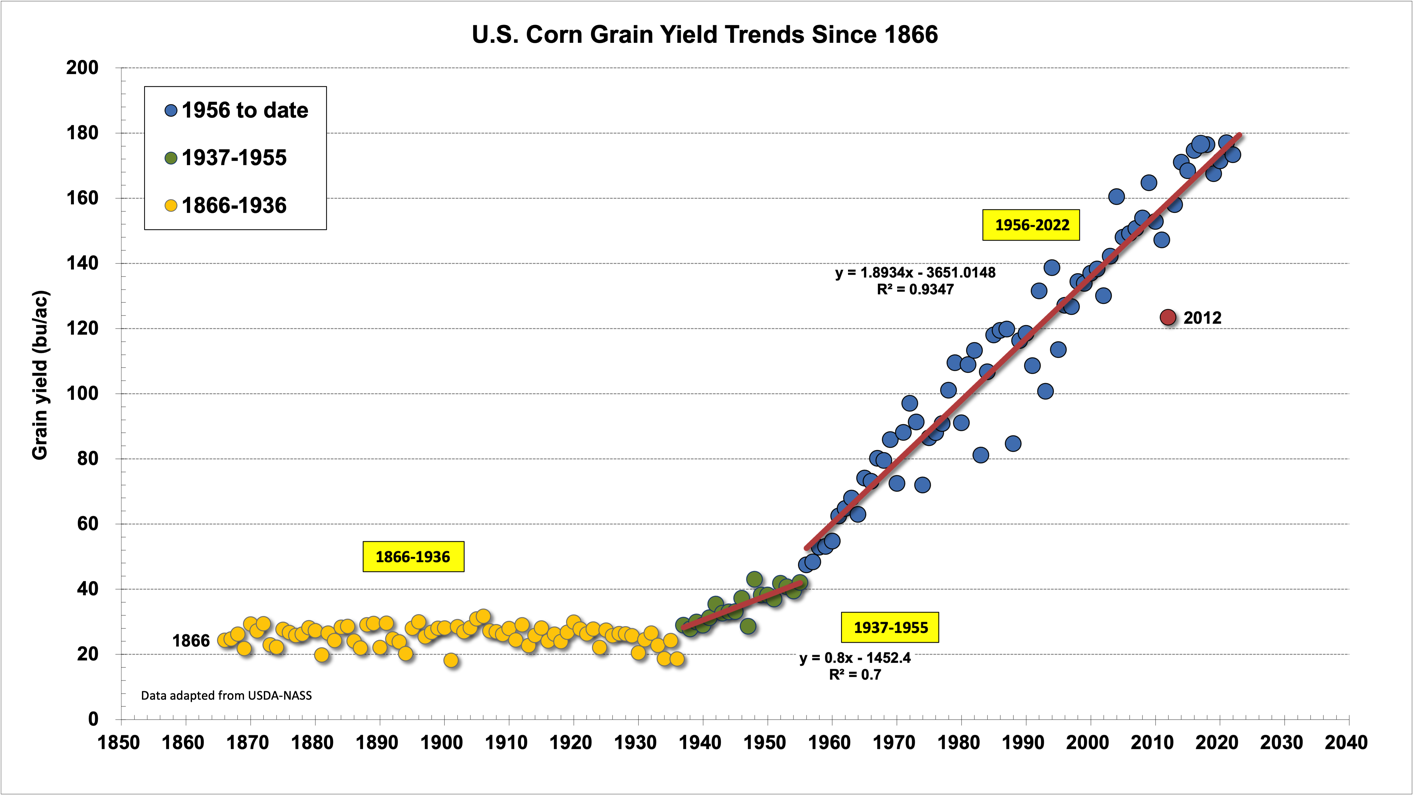
You want big crops?
You want enough food to try to feed the world?
You MUST have alot of nitrogen.
There is NO substitute for the nitrogen to boost plant/crop growth. There will never be a substitute because of the solid agronomic principles that have ruled since plants first evolved.
That's the main use for nitrogen from humans on this planet. Totally ESSENTIAL nitrogen use.
++++++++++++++++++++++++++++++++++++++++++
Fertilizers Data Explorer
https://ourworldindata.org/fertilizers
The complexities of the global food system make it challenging to provide a firm figure, however, it’s likely that just under half of the global population is dependent on synthetic nitrogen fertilizers. This is further shown in the chart. As a result, the Haber-Bosch process is likely to have enabled the lives of at least 3 to 3.5 billion people today.
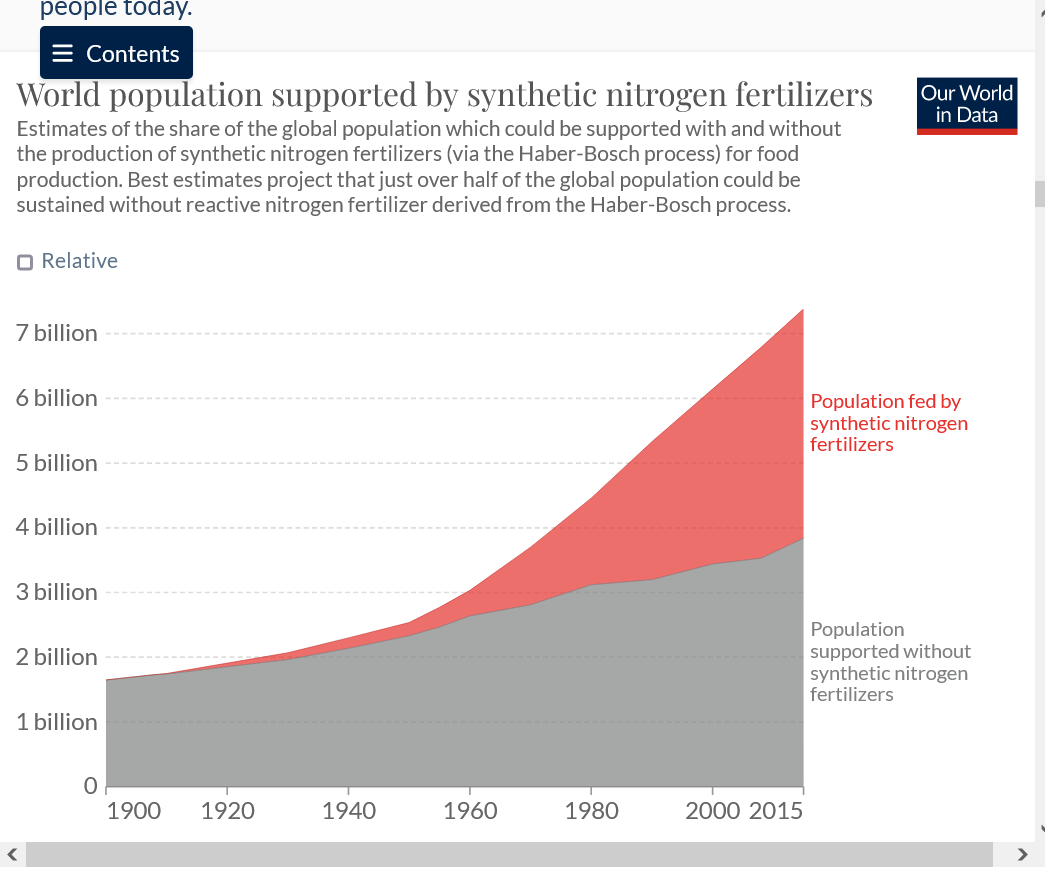
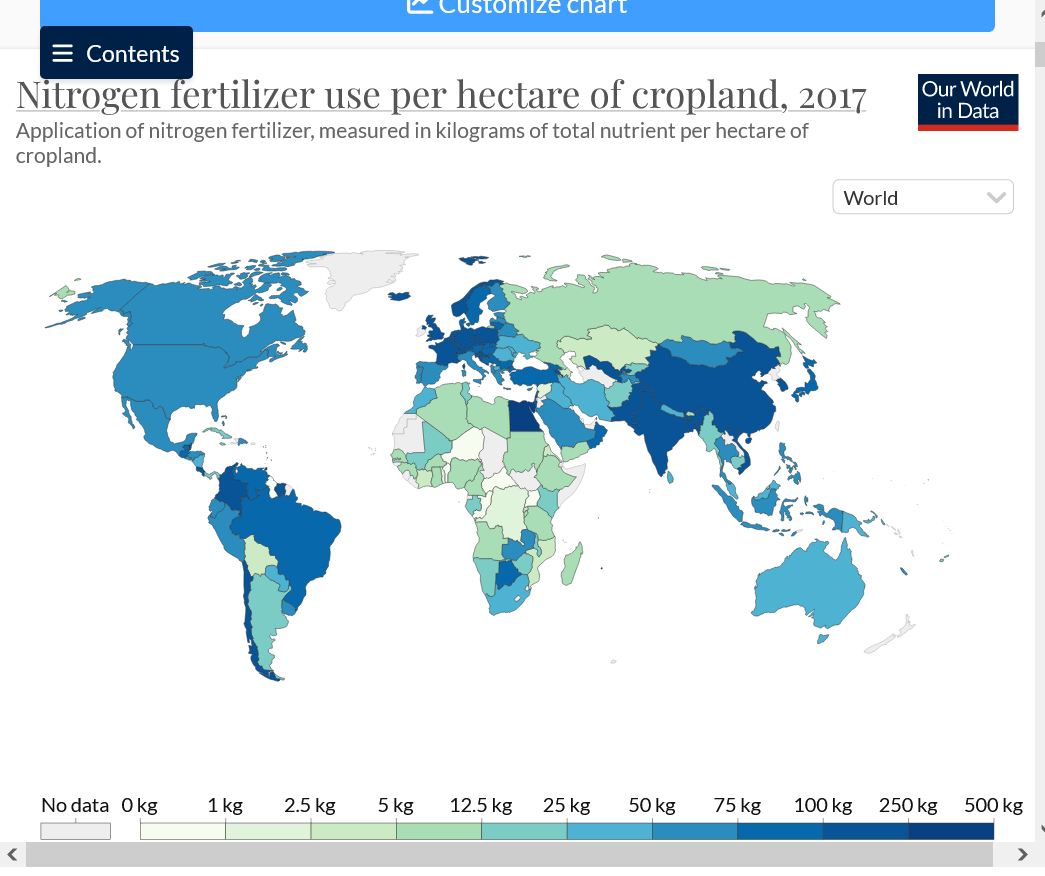
++++++++++++++++++++++++++++++++++++

+++++++++++++++++++++++++++++++++++
++++++++++++++++++++++++++++++++++++++++++++++++++++++++++++++++++++++++++
Vegetables need varying amounts of nitrogen (N) during the growing season for maximum production and quality
A chronology of human understanding of the nitrogen cycle†
https://www.ncbi.nlm.nih.gov/pmc/articles/PMC3682740/
metmike: There's the Haber-Bosch process I explained in the previous linked thread which is feeding BILLIONS of people on this planet that would starve without it.
"The most beneficial impact of the human alteration of the N cycle is that it supports food production for approximately 50 per cent of the world's population"
Let's repeat that again:
"The most beneficial impact of the human alteration of the N cycle is that it supports food production for approximately 50 per cent of the world's population"
What about the damage done to the climate from NO2?
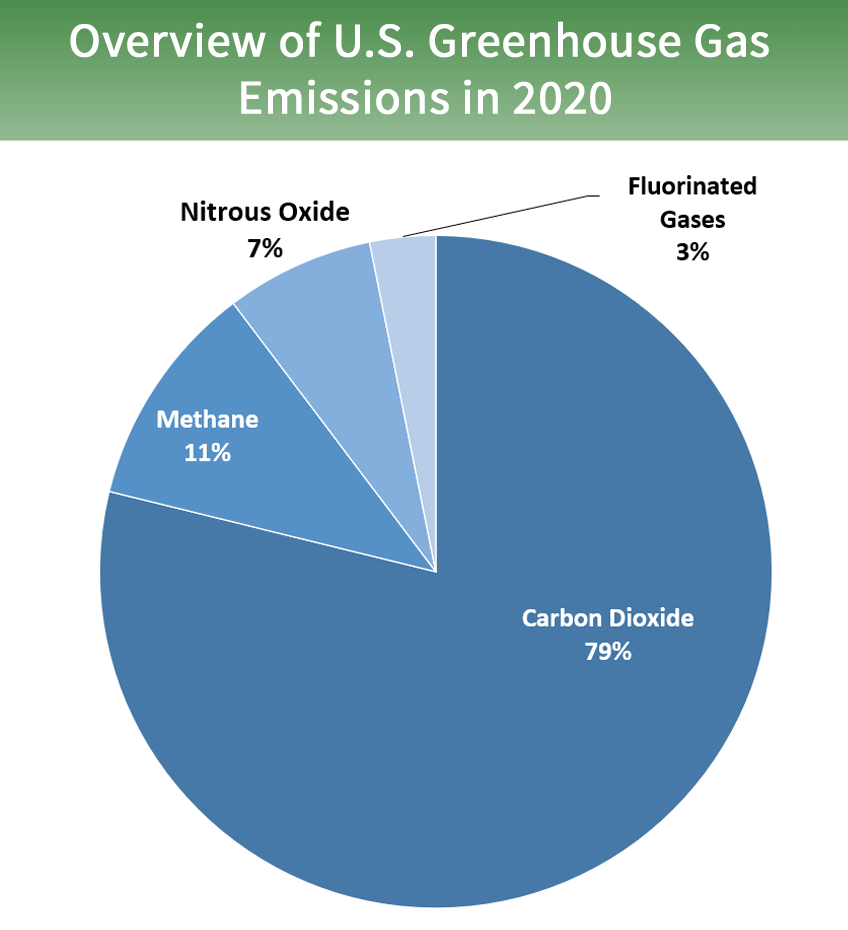
++++++++++++++++++++++++++++++++++++
On the pie chart below, the 74% agricultural soil contribution is from CROP farmers(especially crops like corn and wheat) that are part of producing food for the people on this planet.
You want enough food to feed the planet? You need tons of nitrogen to feed the crops.
THERE IS NO OTHER OPTION!
But this is NOT these Dutch animal farmers. They would mainly be contributing a minuscule fraction from the 5% manure and urine from the cows.......to PRODUCE FOOD(meat)!
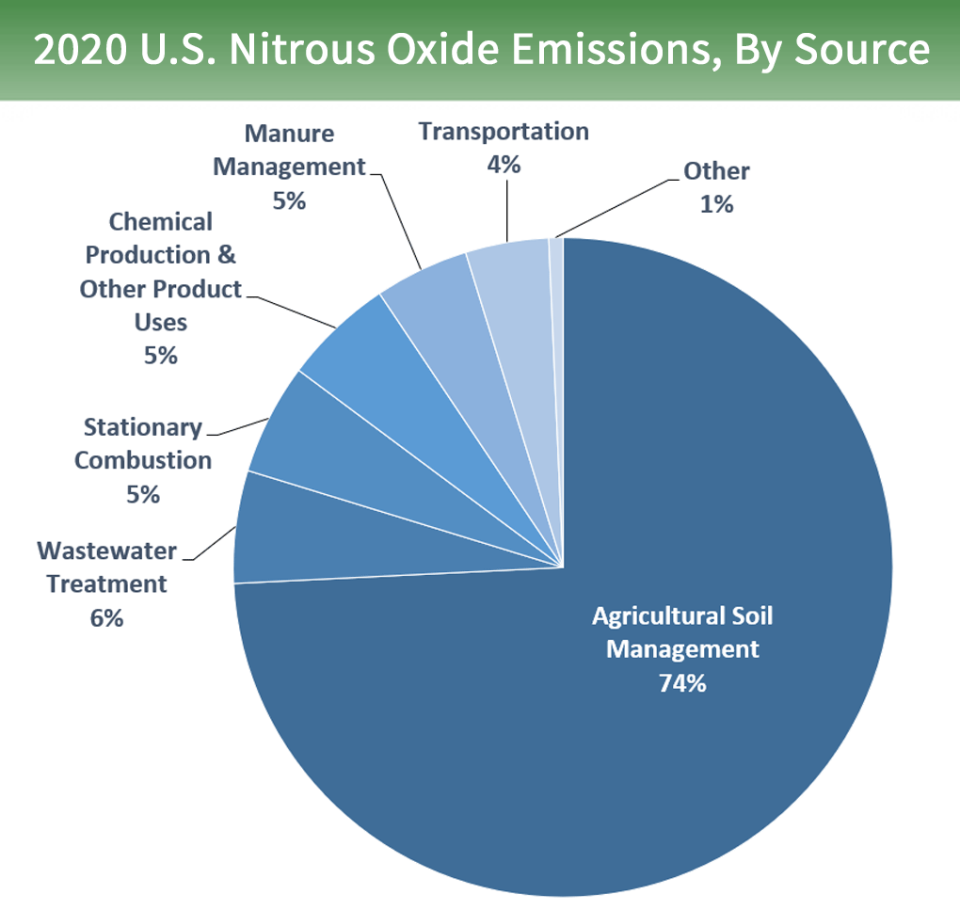
They are totally barking up the wrong tree going after nitrogen in the air for food production.
Nitrogen and fertilizers that RUN OFF into streams and rivers is a very serious problem and is REAL POLLUTION!
But this is NOT why this law was passed. It was passed for a complete bs reason.
Therealenvironmental crisis's/insects dying-dead zones-aquifers drying up-plastics in the ocean-landfills/trash-over consumption of natural resources-REAL pollution in the air/soil/water (metmike is a PRACTICING environmentalist): April 2019
https://www.marketforum.com/forum/topic/27498/
#2 Threat:
Massive dead zones around the world from agricultural activity(water pollution).
https://en.wikipedia.org/wiki/Dead_zone_(ecology)
Dead zones are hypoxic (low-oxygen) areas in the world's oceans and large lakes, caused by "excessive nutrient pollution from human activities coupled with other factors that deplete the oxygen required to support most marine life in bottom and near-bottom water. (NOAA)".[2] Historically, many of these sites were naturally occurring. However, in the 1970s, oceanographers began noting increased instances and expanses of dead zones. These occur near inhabited coastlines, where aquatic life is most concentrated. (The vast middle portions of the oceans, which naturally have little life, are not considered "dead zones".)

Red circles show the location and size of many dead zones.
Black dots show dead zones of unknown size.
The size and number of marine dead zones—areas where the deep water is so low in dissolved oxygen that sea creatures can't survive—have grown explosively in the past half-century. – NASA Earth Observatory (2008)[1]
This area below is the DEAD ZONE where runoff from the Mississippi goes.

In March 2004, when the recently established UN Environment Programme published its first Global Environment Outlook Year Book (GEO Year Book 2003), it reported 146 dead zones in the world's oceans where marine life could not be supported due to depleted oxygen levels. Some of these were as small as a square kilometre (0.4 mi²), but the largest dead zone covered 70,000 square kilometres (27,000 mi²). A 2008 study counted 405 dead zones worldwide.[3][4]
https://www.futurity.org/phosphorous-algae-freshwater-1702482-2/
Though essential to plant growth and a key trace element of many organisms, an overabundance of phosphorus in river basins can cultivate algae blooms in freshwater gulfs and lakes that those rivers feed. The eventual decomposition of the algae consumes vast amounts of oxygen, creating so-called dead zones that choke out marine life.
A dead zone the size of New Jersey occupies the Gulf of Mexico.
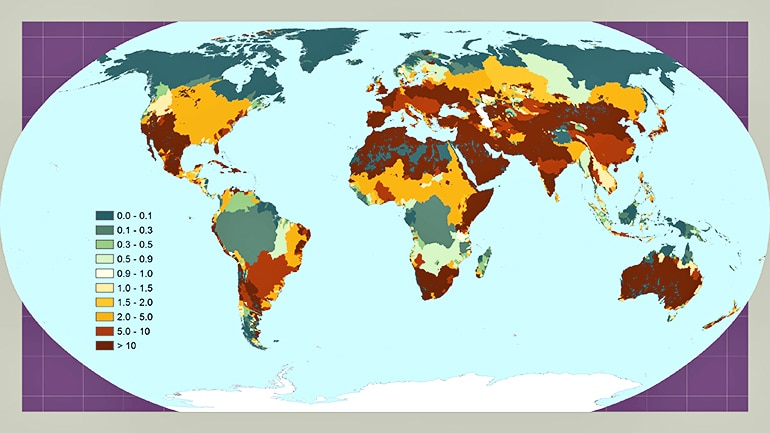
metmike: What makes this so retarded is that it's all about nitrogen emissions into the atmosphere, worshiping the imaginary climate crisis God and not at all about excessive nitrogen in the soils and runoff doing damage to lakes and rivers (legit environmental problem).
The EPA and farmers in the US are not exactly friends because modern farming is always going to produce lots of pollution.
That's a fact of life and it will never change. We can do smart things to help reduce fertilizer over use and try to lessen the amount of it in runoff but what they are doing to these farmers is exactly what NOT to do.
We have 8 billion people on the planet that need to eat. We can't stop growing food and instead, plant trees where we are currently growing crops.
Accept that, please.
We also need energy for our cars, houses and other tools. We can't go back to the stone age and give all that up or use a not viable fairy tale fake green energy plan that will cost 433 trillion in just the US.
If we want to feed more people and help the poor countries the most, then stop all the damage being imposed by counterproductive laws like this one to fight a fake climate crisis.
Then, focus resources on fighting some unnecessary pollution and REAL pollution which can actually be reduced without causing 10 times more damage than the problems/pollution!
I discussed this topic on my favorite radio station.........The Drew Mariani show on Wednesday. In fact, that's what inspired this thread to begin with!
It starts around the 29 minute mark on 7-6-22.
https://relevantradio.com/2022/07/farmers-in-holland-protesting-green-enforcement/
https://wattsupwiththat.com/2022/07/12/carbon-brief-cuba-shows-we-can-live-without-fertiliser/
+++++++++++++++++++++
Mike Maguire
July 12, 2022 9:06 pm
You can’t defy the laws of photosynthesis and agronomy.
Plants MUST HAVE H2O, CO2 and certain minerals(fertilizers, like nitrogen) for their roots to uptake.
In most cases, the more you increase those elements, the more productive the plant will be.
There’s an optimal level for all those elements for each plant that varies under wide ranging conditions.
Having less than optimal levels of any element, will cause a reduction in yield and/or reduction in the amount of something(s) in the plant that was negatively impacted by the sub optimal conditions.
Synthetic fertilizers, especially those loaded with nitrogen, allow humans to create a near optimal soil environment to grow plants.
Without them, soil conditions will not be near optimal and plants will not do as well.
This is agronomy 101.
This is feeding billions of people on the planet right now.
https://ourworldindata.org/fertilizers
++++++++++++++++++++++++++++++
Mike Maguire
Reply to Mike Maguire
July 12, 2022 9:08 pm
+++++++++++++++++++++++++++
Mike Maguire
Reply to Mike Maguire
July 12, 2022 9:15 pm
Another secret about fossil fuels: Haber Bosch process-fertilizers feeding the planet using natural gas-doubling food production/crop yields. https://www.marketforum.com/forum/topic/39215/
it seems that environmental lunacy knows no bounds. at what point will the public rebel against this trend?
the economies of europe are stagnating and going down the drain. unfortunately, most people in europe are happy to have more big bureaucracy, and ridiculous rules.
Yes bear, it's pure anti science lunacy!
And crystal clear to anybody that understands agronomy, photosynthesis, nutrition and world food production that this path will be a disaster.
https://wattsupwiththat.com/2022/07/11/trudeaus-nitrogen-policy-will-decimate-canadian-farming/
Scientific American has been an extreme source of the exaggerated climate crisis the last 2 decades(yeah, I know that seems impossible-but I've been reading it since 1982-and they were part of how I got fooled in the 1990s). As it turns out, 80% of scientists are liberal so that's no surprise.
Anyway, they make some good points in the articles below.
A five-step global plan could double food production by 2050 while greatly reducing environmental damage
https://www.scientificamerican.com/article/can-we-feed-the-world/
Reducing yield gaps in the least productive agricultural lands may often require some additional fertilizer and water.
With fertilizers, we face a kind of Goldilocks problem. Some places have too few nutrients and therefore poor crop production, whereas others have too much, leading to pollution. Almost no one uses fertilizers “just right.” Our analysis shows hotspots on the planet—particularly in China, northern India, the central U.S. and western Europe—where farmers could substantially reduce fertilizer use with little or no impact on food production. Amazingly, only 10 percent of the world’s cropland generates 30 to 40 percent of agriculture’s fertilizer pollution.
Among the actions that can fix this excess are policy and economic incentives, such as payments to farmers for watershed stewardship and protection, for reducing excessive fertilizer use, for improving manure management (especially manure storage, so that less runs off into the watershed during a storm), for capturing excess nutrients through recycling, and for instituting other conservation practices. In addition, restoring wetlands will enhance their capacity to act as a natural sponge to filter out nutrients in runoff.
Scientists have made bold advances in biology and genetics that offer unprecedented power to tailor food crops to the environment, and to the needs of consumers.
https://www.scientificamerican.com/custom-media/pictet/the-science-of-feeding-the-world/
With regards to increasing yields using better hybrids and genetics.
This has been effective now for many decades, however it eventually runs into a brick wall.
The energy in a plant used for animal consumption was acquired while it grew.
Where did all the energy come from:
Photosynthesis!
You can improve a plants ability to perform photosynthesis by altering genetics and creating new hybrids but a key, non negotiable factor will always be inputs. You can cause a plant to be more effective at making energy but that also requires giving it the input tools(like fertilizers) to increase the components/parts of the plant that generate more energy(from photosynthesis).
https://www2.estrellamountain.edu/faculty/farabee/biobk/biobookener1.html
First Law of Thermodynamics: Energy can be changed from one form to another, but it cannot be created or destroyed. The total amount of energy and matter in the Universe remains constant, merely changing from one form to another. The First Law of Thermodynamics (Conservation) states that energy is always conserved, it cannot be created or destroyed. In essence, energy can be converted from one form into another. Click here for another page (developed by Dr. John Pratte, Clayton State Univ., GA) covering thermodynamics.
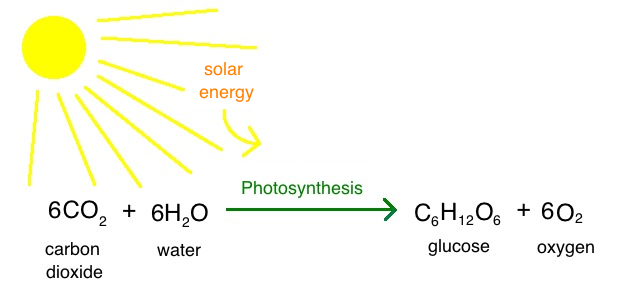
Plants are made out of something. The material to make up plants has to come from somewhere. That something is fertilizer(minerals in the ground), CO2 and water.
One of the more profoundly absurd things about these proposed cutbacks to the use of synthetic fertilizers in the soil is that they are also trying to reduce fertilizer in the air..........CO2.
For instance, where will plants get their materials/inputs for making leaves(mostly nitrogen) to gather sunshine and collect CO2 if you cut back on nitrogen?
Where will they get the rest of the minerals that are deficient in almost all natural soils if you don't add them with fertilizers?
Answer...........there is no magic source. There is no green fairy dust that we can sprinkle on plants to replace fertilizers. You either add fertilizer or the plants can't optimize their growth and yield/food production. There is no refuting or altering this indisputable law of agronomy. Legislation to greatly reduce the amount of fertliizer/nitrogen in the soils WILL reduce food production. Not an opinion. That's a physical law as explained above.
We can do a better job managing run off from excessive fertilizer that does significant damage to our surface water systems/ecosystems but plants have always needed their nutrients and WILL always need their nutrients, which will almost never be optimal in unfertilized soil.
An exception to this would/will be when we engineer MORE plants to extract their nitrogen from the atmosphere(actually, convert N2 to NH3 in the soil-even though they are trying to reduce NH3 in the soils)…..nitrogen fixation (atmosphere is 78% nitrogen).
Until that happens, we’re stuck with giving them the essential nitrogen via the soils and when this is replaced by nitrogen fixation…………it’s still nitrogen they are pulling from the air. In some places, where synthetic fertlizers are NOT used, this will actually INCREASE the amount of nitrogen/NH3 in the soils. Great for the plants there but is the opposite of the absurd objective.
https://www.wtamu.edu/~cbaird/sq/2014/02/21/how-do-plants-get-their-nitrogen-from-the-air/
Bacteria and archaea in the soil and in the roots of some plants have the ability to convert molecular nitrogen from the air (N2) to ammonia (NH3), thereby breaking the tough triple bond of molecular nitrogen.
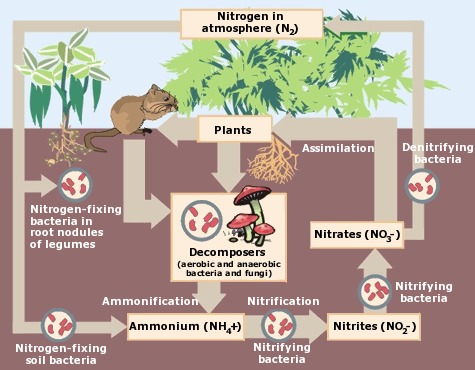
https://www.nature.com/scitable/knowledge/library/biological-nitrogen-fixation-23570419/
https://www.ruralsprout.com/nitrogen-fixing-plants/
These last 2 posts were generated to post under this article:
https://wattsupwiththat.com/2022/07/12/carbon-brief-cuba-shows-we-can-live-without-fertiliser/
By focusing on natural versus synthetic, the organic rule loses sight of actual risks. Copper sulfate is permitted as a fungicide because it isn’t synthetic, but careless use of this chemical can leave dangerous residues on food and pollute our streams. Animal manure is natural, and an excellent fertilizer when composted, but dangerous bacteria will be introduced into fields and also into groundwater systems if a farmer fails to get the heat in the compost pile up to at least 140 degrees.
A close friend with a field of organic blueberries on her hilltop farm in Maine developed serious stomach problems when she located her compost pile too close to the well.
The biggest weakness in the organic rule is absolutism. Cutting back on the use of manufactured fertilizer is frequently a good idea, but the idea of cutting back to zero is needlessly rigid and absolute. Quests for purity in food and farming are not as dangerous as they are in race or religion, but they are just as lacking in scientific justification, and the advocates can be just as exasperating. Calvin Trillin put it nicely: “The price of purity is purists.”
The conviction that organic food is a better choice did not become widespread in the United States until the 1980s, when national media reported a number of food safety scares linked to pesticide residues on fresh fruits and vegetables. When worried consumers learned that organic farming methods did not allow the use of any synthetic pesticides (although naturally occurring poisons could be used), they demanded more organic products, along with a credible national system for certifying and labeling those products in the marketplace. Once this system began to operate in 2002, the farmers who had switched to organic methods could capture sizable price premiums for their goods, and this motivated rapid growth in the sector, but only up to a point.
After two decades of popularity with consumers, the organic share still makes up only a small part of America’s national diet. The most popular organic produce choices today are carrots, lettuce, and apples, yet they take up only 14, 12, and 5 percent of total acreage for these crops. Only 3 percent of U.S. dairy cows and just 2 percent of layer hens are certified organic. As for field crops, here the organic share of production is even less significant: In 2016, only six-tenths of 1 percent of total harvested wheat acres in the United States were farmed organically.
Consumers pay considerably more for organic. In 2018, the Food Marketing Institute reported that the average retail price (by volume) for organic produce was 54 percent higher than for conventional produce. One USDA study showed that organic salad mix cost 60 percent more than conventional; organic milk 72 percent more; and organic eggs 82 percent more. Organic corn and soybeans sell for twice as much as conventional. These are high premiums, but not high enough to move most farmers toward organic, because the farming costs required by organic methods can be higher still.
There is nothing novel about producing foods without the use of synthetic chemicals. Before science first made these chemicals available to farmers early in the 20th century, all crops were de facto organic. When synthetic nitrogen first became available for fertilizer, farmers who began using it saved on labor and enjoyed higher crop yields. The timing was fortunate, since the earth’s population was just then in the process of increasing from two billion up to nearly eight billion today. Vaclav Smil, from the University of Manitoba, has estimated that without nitrogen fertilizer, 40 percent of the increase in food production needed to feed these much larger numbers would never have taken place. For at least a third of humanity in the world’s most populous countries, the use of nitrogen fertilizer in the 20th century made the difference between an adequate diet and malnutrition.
https://www.foodsafetynews.com/2016/11/cdc-study-attempts-to-assess-outbreak-risk-from-organic-food/
Fresh off the E. coli and salmonella outbreaks this spring, Shelley Rankin, professor of microbiology at the School of Veterinary Medicine, explains key differences between the bacteria—and what to do to avert them.
https://penntoday.upenn.edu/news/how-avoid-food-poisoning-e-coli-and-salmonella
https://www.hindawi.com/journals/ijfs/2016/4767453/
Application of contaminated poultry manure to the crops in gardening sites may result in contamination of vegetables by the following fecal bacteria: fecal coliforms, Escherichia coli, and fecal streptococci. Our study has demonstrated that the use of poultry manure as fertilizer during the agronomic trials has influenced the fecal bacteria counts recorded on the vegetables. The long traditional use of poultry manure which probably left fecal bacteria in the soil and water in the study area before the beginning of the trials is another probable explanation.
This statement of the environment constitutes a genuine danger for the public health: that of the farmers, local populations, and the consumers of the vegetables produced in the area. The combination of market gardening and livestock rising is widely considered to be a good way to increase plant yields. But our results show that it can also have negative impacts on human health. For this reason, to achieve sustainable urban agriculture in Africa, those designing innovative cropping systems need to be mindful of the environment and of public health concerns and such systems should be developed through multidisciplinary research that includes more medical, biological, environmental, and socioeconomic components.
https://www.makefoodsafe.com/manure-meandering-read-this-before-you-plant-your-veggies/
Manure can be a great base for compost. The leavings of cows, horses, and other grass-munching herbivores are rich in nitrogen, phosphorus, and potassium, which are all necessary ingredients for cooking up healthy soil. Manure is readily available, too – a single cow produces between 40 and 120 pounds a day. Talk about a renewable resource! But is compost made from manure safe to grow your food in? Read this before you Plant Your Veggies!
The Germ Problem
The problem with manure is that some of the things that live in it can make you sick. It’s rich in bacteria, the majority of which are harmless. Some of the bacteria found in manure, however, is dangerous. Common offenders in cow manure include E. coli, Salmonella, and other pathogens that can make you sick. If that bacteria makes it from manure for compost into your system, you’re liable to experience nausea, vomiting, fever, and other symptoms typical of food poisoning.
It is the raw manure though that is the biggest concern. According to a study reported in the American Society for Microbiology,
“Animal waste in the form of raw manure or composted manure is routinely applied to the land as a crop fertilizer and/or soil amendment. Compost also is used as a growth medium in home gardening, ornamental nurseries, and greenhouses. A potential risk arising from the disposal of animal waste of fecal origin is the spread of enteric pathogens. Animals from which food is derived are recognized as reservoirs of many significant food-borne pathogens, including Escherichia coli O157:H7, Salmonella spp., and Campylobacter spp. Many outbreaks or cases of E. coli O157:H7 infection have been associated with water or food directly or indirectly contaminated with animal manure. For example, an outbreak of E. coli O157:H7 infection among members of four families was associated with food fertilized with cattle manure on the farm. In another instance, a woman acquired E. coli O157:H7 infection associated with eating inadequately washed vegetables that were obtained from a garden fertilized with bovine manure.”
Food contamination can come from numerous sources.
https://www.ncbi.nlm.nih.gov/pmc/articles/PMC8199310/

This post relates the topic to this Summer's hype over exaggerated drought and heat being FALSELY blamed/caused by climate change:
https://www.marketforum.com/forum/topic/87422/
A brief history of U.S. #corn yield growth since the 1860s Notable growth in yields was seen after the adoption of modern fertilizers in the 1940s, which made drought years esp. in the 1980s stand out more than before (compare with 1930s Dust Bowl for example).
++++++++++++++++++++++++++++++
metmike: Crop yields dropping in the 1930's were related to this, below:
https://www.marketforum.com/forum/topic/56668/#56673
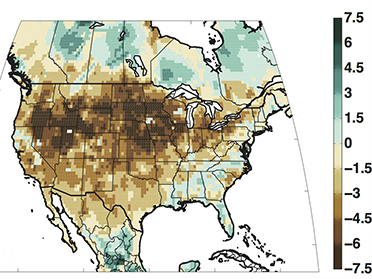
https://www.marketforum.com/forum/topic/67004/

+++++++++++++++
https://www.marketforum.com/forum/topic/87422/#87425

https://wattsupwiththat.com/2022/08/08/net-zero-is-not-just-for-carbon-emissions-now-its-nitrogen/
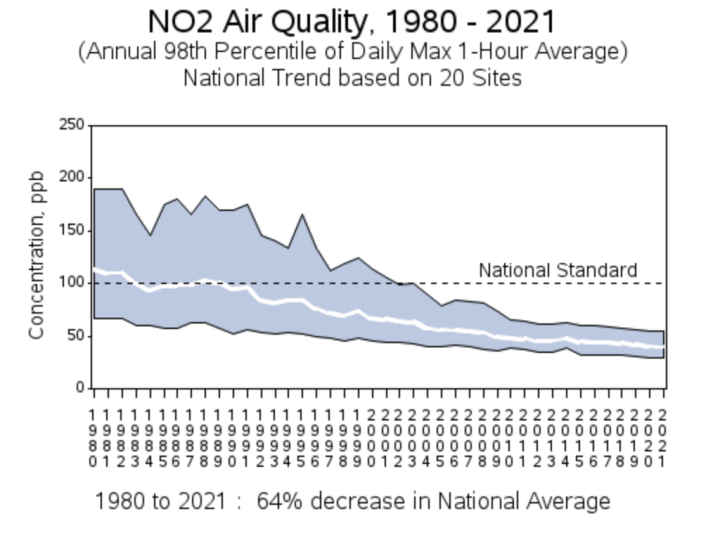
metmike: Synthetic fertilizer feeds half the planet. Look how dinky the wavelength bands capturing long wave radiation from NO2 are below.
H2O, the main greenhouse gas has a concentration in the earths atmosphere of around 100,000 times more than NO2, as well as being able to absorb heat over a 100 times wider area in the absorption spectrum.
In other words..........this is clearly NOT based on atmospheric physics. The slight warming has been mostly beneficial to life to begin with.
This is junk, anti science DISinformation on steroids and crack.
https://commons.wikimedia.org/wiki/File:Atmospheric_Transmission.png

Previous thread with more science to explain this:
Hot Summer NOT caused by climate change/the science
Started by metmike - July 22, 2022, 7:08 p.m.
https://rgs-ibg.onlinelibrary.wiley.com/doi/10.1111/geoj.12475

The government in the Netherlands is planning to conduct forced buyouts of 3,000 Dutch farms with the intention of closing them down to cut nitrogen emissions in half to meet the country’s climate goals. As many as 11,200 farms will have to close, and another 17,600 farmers will have to significantly downsize their livestock operations to meet these draconian targets.
Thanks cutworm,
there are 8 billion people to feed on the planet and growing.
turning back the climate clock to conditions similar to 100 years ago, supposedly the optimal CO2 and global temperaure would cause 1 billion people to starve to death within 3 years because of food production plunging and rationing would result in prices tripling.
on top of that, if you completely eliminated synthetic fertilizers Like those mentioned in your article, another 1 to as many as 2 billion people would die of starvation and only rich people could afford to eat.
of course this will never get close to happening because it will soon be so painfully obvious what the severe consequences are to these completely retarded, anti science, anti agronomy, anti energy, anti human, fake environmentalism, fake climate crisis actions are that people will revolt and reject all of it before the consequences get too extreme.
the world has gone nuts!
people no longer need to prove that plans, like switching to fake green energy or eliminating synthetic fertilizers will work like in other fields.
they just promise it will save the planet, then make up absurd actions that have a near zero chance of working and this gives them free reign to impose stuff that belongs in a fairy tale or science fiction book.
Below: Look what happened to corn crop yields when we started adding synthetic nitrogen fertilizers to the soils.
Adding CO2 to the air is also having a huge fertilization affects on plants.
https://www.marketforum.com/forum/topic/86882/#87765
Nitrogen in the corn plant:
https://extension.missouri.edu/publications/wq259
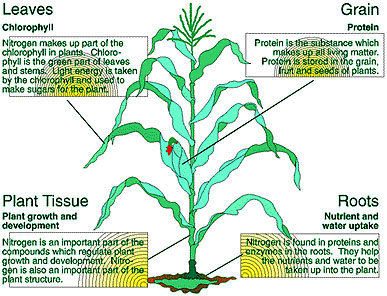
They're taking this action to meet climate goals for the POLITICAL Climate Accord based on global climate models using hand pick mathematical equations to manufacture a simulation of the atmosphere going out to the year 2100.
They've all been too warm for 3 decades but they never get adjusted downward to the science based on empirical data/observations because they aren't science. They are political tools to be used to justify absurd actions like this one.
This was one of my favorite discussions when it was becoming increasingly obvious a decade ago. Yes, temperatures are going up but not fast enough to take extreme actions, like the ones currently taking place based on computer generated simulations of the fake atmosphere based on global climate models.
https://www.drroyspencer.com/2014/02/95-of-climate-models-agree-the-observations-must-be-wrong/
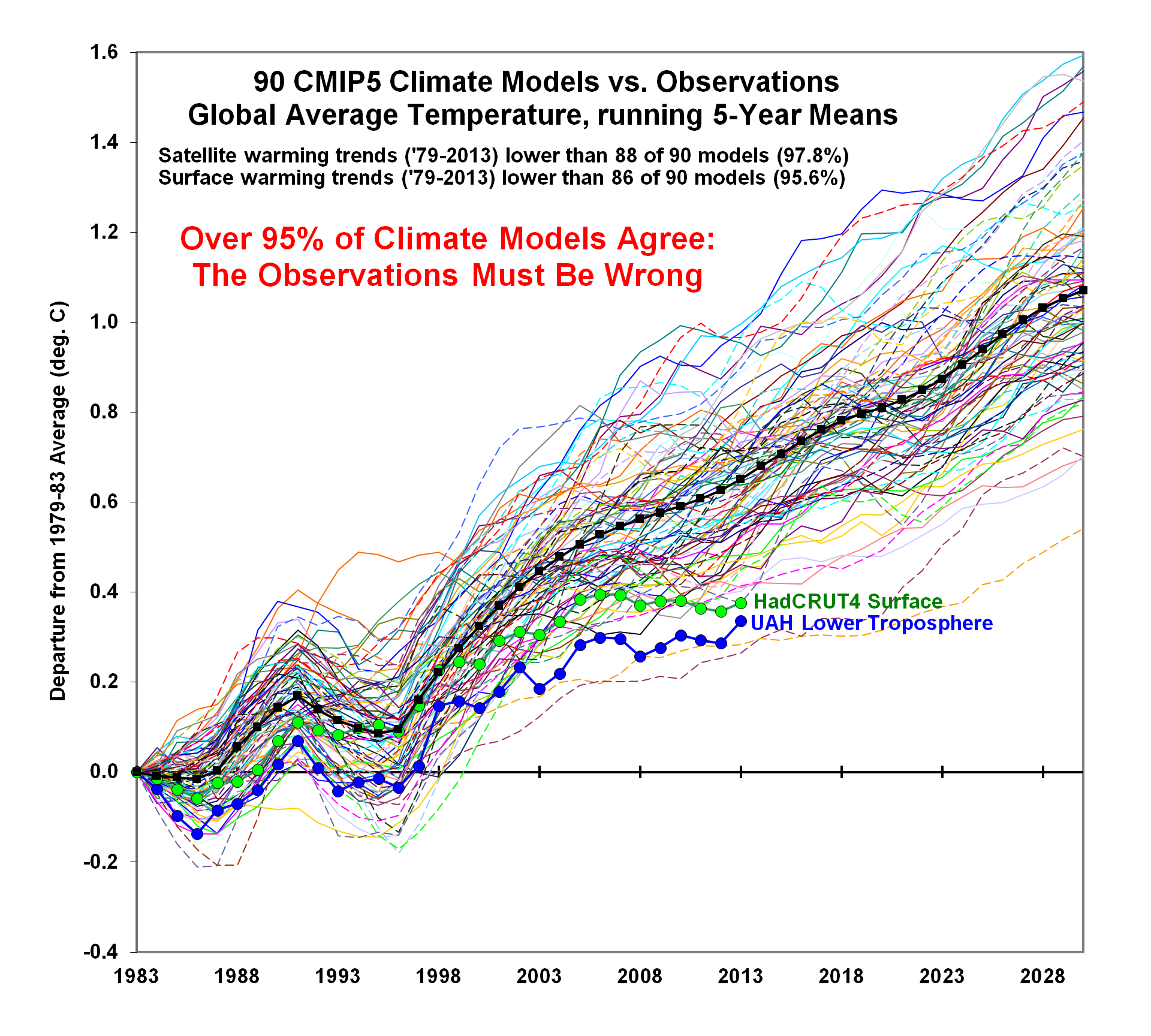
We need to take these extreme actions to save the planet from the things that are greening up the plane and massively increasing crop yields(during the current climate optimum for life-being called a climate crisis)
DeathbyGreening:
https://www.marketforum.com/forum/topic/69258/